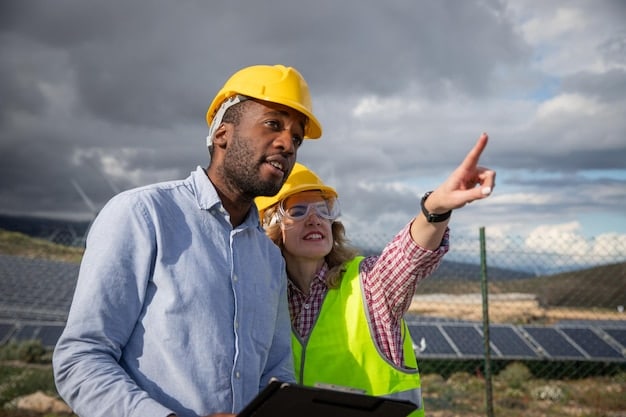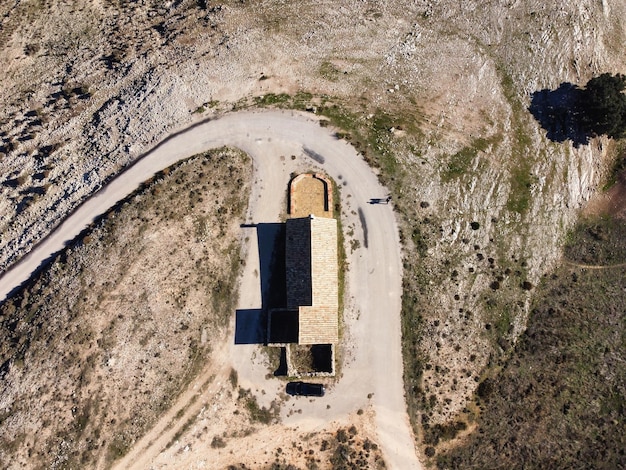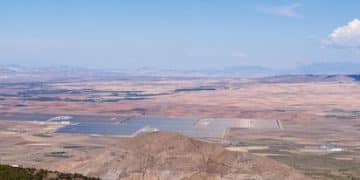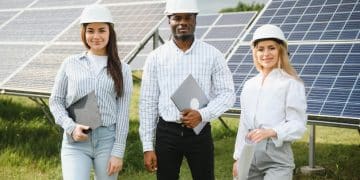Ensuring a Just Transition for Fossil Fuel Workers in the US

Ensuring a just transition for workers in the fossil fuel industry in the US involves comprehensive strategies such as retraining programs, investment in new industries, community support, and policy changes that address the economic and social impacts of transitioning to a cleaner energy economy.
The shift towards renewable energy presents both opportunities and challenges for the United States, particularly for workers in the fossil fuel industry. How can the US ensure a just transition for workers in the fossil fuel industry, providing them with the necessary support and resources to thrive in a changing energy landscape?
Understanding the Need for a Just Transition
The transition from fossil fuels to renewable energy sources is crucial for mitigating climate change and achieving long-term environmental sustainability. However, this transition has significant implications for the workers and communities that depend on the fossil fuel industry.
A just transition aims to ensure that these workers and communities are not left behind. It involves providing them with the necessary support to adapt to new economic realities, creating new job opportunities, and fostering economic diversification.

Economic Impacts of the Energy Transition
The decline of the fossil fuel industry can lead to job losses, reduced local tax revenues, and economic hardship for communities that heavily rely on coal, oil, and natural gas. It is essential to understand these impacts to develop effective transition strategies.
Addressing these challenges requires a multi-faceted approach that includes job retraining programs, investments in infrastructure, and policies that support economic diversification.
- Investing in education and training programs to equip workers with skills needed for jobs in the renewable energy sector.
- Supporting local businesses and entrepreneurs to create new job opportunities in diversified industries.
- Providing financial assistance and social safety nets to support workers and families during the transition.
Ultimately, a just transition seeks to create a more sustainable and equitable economy, where workers and communities can thrive in the face of a changing energy landscape.
Retraining and Education Programs
One of the most critical components of a just transition is providing workers with the skills and knowledge needed to succeed in new industries. Retraining and education programs can play a vital role in this process.
These programs should be tailored to the specific needs of workers and communities, offering training in high-demand fields such as renewable energy, energy efficiency, and sustainable manufacturing.
Effective Retraining Strategies
Effective retraining programs should be accessible, affordable, and relevant to the local job market. They should also provide support services such as career counseling, job placement assistance, and financial aid.
Partnerships between educational institutions, industry, and government agencies can help ensure that retraining programs are aligned with the needs of employers and workers.
Successful retraining programs also incorporate hands-on training, apprenticeships, and on-the-job learning experiences to provide workers with practical skills and real-world experience.
- Offer comprehensive training programs in renewable energy technologies, such as solar panel installation and wind turbine maintenance.
- Provide career counseling and job placement assistance to help workers find new employment opportunities.
- Establish partnerships with local businesses and industry to ensure that training programs are aligned with employer needs.
By investing in retraining and education, the US can help ensure that workers in the fossil fuel industry have the skills they need to thrive in a rapidly changing economy.
Investing in Renewable Energy Infrastructure
Investing in renewable energy infrastructure is essential for creating new job opportunities and driving economic growth in communities affected by the energy transition.
This includes investments in wind, solar, hydro, geothermal, and other renewable energy projects, as well as in the transmission and distribution infrastructure needed to deliver clean energy to consumers.
Benefits of Renewable Energy Investments
Renewable energy projects can create new jobs in manufacturing, construction, installation, maintenance, and other related industries. They can also generate local tax revenues and stimulate economic activity in rural areas.
In addition to creating jobs, renewable energy investments can help diversify local economies, reduce dependence on fossil fuels, and improve air quality and public health.

By prioritizing renewable energy investments, the US can create a more sustainable and resilient economy, while also providing new opportunities for workers and communities affected by the energy transition.
- Prioritize investments in renewable energy projects in communities that have been historically dependent on the fossil fuel industry.
- Provide financial incentives and tax credits to encourage private sector investment in renewable energy.
- Streamline permitting processes to accelerate the development of renewable energy projects.
Ultimately, investing in renewable energy infrastructure is a win-win scenario that can create jobs, stimulate economic growth, and reduce carbon emissions.
Community Development and Diversification
A just transition requires a focus on community development and diversification, helping communities that have been historically dependent on the fossil fuel industry to build more resilient and sustainable economies.
This involves investing in infrastructure, education, healthcare, and other essential services, as well as supporting local businesses and entrepreneurs.
Strategies for Community Diversification
Diversifying local economies can reduce dependence on a single industry and create new opportunities for growth and development. This can include supporting the development of new industries such as tourism, technology, and sustainable agriculture.
Community development initiatives should also focus on improving the quality of life for residents, by investing in affordable housing, parks and recreation, and cultural amenities.
Engaging local residents in the planning and decision-making process is essential for ensuring that community development initiatives are aligned with the needs and priorities of the community.
By investing in community development and diversification, the US can help ensure that communities affected by the energy transition are able to thrive in the long term.
- Provide funding for community development projects that support economic diversification and job creation.
- Offer technical assistance and training to local businesses and entrepreneurs.
- Invest in infrastructure improvements to support economic growth and improve quality of life.
Overall, community development and diversification are essential components of a just transition, creating more resilient and sustainable economies.
Policy and Regulatory Frameworks
Effective policy and regulatory frameworks are essential for ensuring a just transition. These frameworks should provide clear guidance, incentives, and standards for businesses, workers, and communities.
This includes policies that support renewable energy development, promote energy efficiency, and protect workers’ rights and benefits.
Key Policy Considerations
Policy frameworks should also address issues such as job retraining, unemployment benefits, and healthcare coverage for workers affected by the energy transition. It must ensure that these considerations are thoroughly taken into account.
Regulations can also be used to promote responsible environmental practices and ensure that renewable energy projects are developed in a sustainable manner.
Regular review and updating of policy and regulatory frameworks are essential for ensuring that they remain effective and responsive to changing economic and technological conditions.
- Enact policies that support the development of renewable energy and incentivize energy efficiency.
- Provide financial assistance and social safety nets for workers and communities affected by the energy transition.
- Establish clear standards for environmental protection and sustainable development.
By establishing effective policy and regulatory frameworks, the US can create a level playing field for businesses, protect workers’ rights, and ensure that the energy transition is managed in a responsible and sustainable manner.
Collaboration and Stakeholder Engagement
A just transition requires collaboration and engagement among a wide range of stakeholders, including government agencies, businesses, labor unions, community organizations, and advocacy groups.
This collaborative approach can help ensure that the needs and perspectives of all stakeholders are taken into account, and that transition strategies are developed in a transparent and inclusive manner.
The Role of Stakeholder Engagement
Stakeholder engagement can also help build trust and support for transition initiatives, by providing opportunities for dialogue, education, and feedback.
Collaborative partnerships can be established to support joint projects, share resources, and coordinate activities. These opportunities are available and should be pursued.
Regular communication and information sharing among stakeholders can help ensure that everyone stays informed about progress, challenges, and opportunities related to the energy transition.
- Establish multi-stakeholder advisory groups to provide input and guidance on transition strategies.
- Organize public forums and workshops to engage local residents in the planning and decision-making process.
- Develop communication strategies to keep stakeholders informed about progress and challenges.
Achieving a just transition requires a concerted effort by all stakeholders, working together to create a more sustainable and equitable future for workers and communities.
| Key Point | Brief Description |
|---|---|
| 🛠️ Retraining Programs | Provide workers with skills for new industries. |
| ⚡ Renewable Energy Investments | Creates jobs in green energy sectors. |
| 🏘️ Community Development | Supports diversified, resilient local economies. |
| 🤝 Stakeholder Engagement | Ensures inclusive and transparent transition. |
FAQ
▼
A just transition ensures that as we move away from fossil fuels to renewable energy, workers and communities are not left behind. It provides resources for new opportunities.
▼
It addresses climate change while protecting the livelihoods of those dependent on the fossil fuel industry. This reduces the negative impacts of industrial changes in energy sector.
▼
Key elements include retraining programs, investment in renewable energy, community development, and protective policies that support affected industrial workers.
▼
Communities can invest in new industries such as tourism, technology, and sustainable agriculture. Promoting small local businesses can reduce industrial reliance too.
▼
Support policies and initiatives that promote community development. Advocate for funding and fair programs. Engage in discussions on a wide variety of ideas in transition.
Conclusion
Ensuring a just transition for workers in the fossil fuel industry in the US requires a comprehensive and collaborative approach. By focusing on retraining and education, investing in renewable energy infrastructure, supporting community development, establishing effective policy frameworks, and engaging stakeholders, the US can create a more sustainable and equitable future for all.





